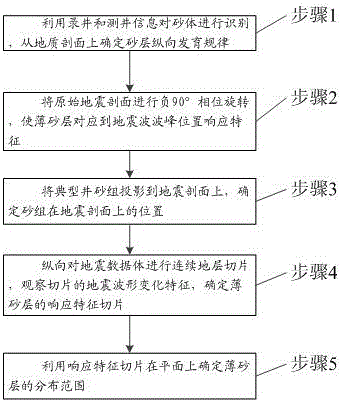Method for predicting distribution of thin sand body
A sand body and thin sand technology, applied in the field of sand body distribution prediction, can solve problems such as difficult identification of thin sand layers
- Summary
- Abstract
- Description
- Claims
- Application Information
AI Technical Summary
Problems solved by technology
Method used
Image
Examples
Embodiment 1
[0045] In Example 1, please refer to figure 1 , providing a method for predicting the distribution of thin sand bodies, the method comprising:
[0046] Step 1: Use mud logging and logging information to identify sand bodies, and determine the longitudinal development of sand layers from the geological section;
[0047] Step 2: Perform negative 90° phase rotation (counterclockwise) on the original seismic profile, so that the thin sand layer corresponds to the seismic wave amplitude (peak position) response characteristics;
[0048] Step 3: Project the typical well sand group onto the seismic section, and determine the position of the thin sand layer on the seismic section;
[0049] Step 4: Continuously slice the seismic data volume vertically, observe the seismic waveform change characteristics of the slices, and determine the response characteristic slices of the thin sand layer;
[0050] Step 5: Use the response feature slice to determine the distribution range of the thi...
PUM
 Login to View More
Login to View More Abstract
Description
Claims
Application Information
 Login to View More
Login to View More - R&D
- Intellectual Property
- Life Sciences
- Materials
- Tech Scout
- Unparalleled Data Quality
- Higher Quality Content
- 60% Fewer Hallucinations
Browse by: Latest US Patents, China's latest patents, Technical Efficacy Thesaurus, Application Domain, Technology Topic, Popular Technical Reports.
© 2025 PatSnap. All rights reserved.Legal|Privacy policy|Modern Slavery Act Transparency Statement|Sitemap|About US| Contact US: help@patsnap.com



